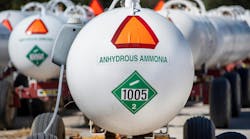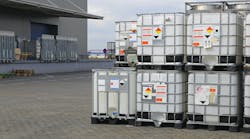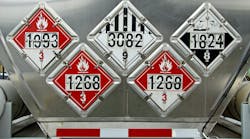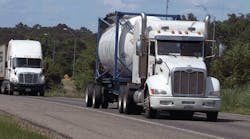Truck industry officials raised some serious concerns in the wake of the June 19 announcement of the joint Environmental Protection Agency’s (EPA) and National Traffic Safety Administration’s (NHTSA's) proposed Phase 2 emissions and fuel-efficiency standards for medium- and heavy-duty trucks. In particular, questions were raised about technology requirements to meet the emission reduction targets.
Leaders at the American Trucking Associations said they want to support the Obama Administration’s second round of greenhouse gas and fuel efficiency rules for commercial trucks, but they are concerned the rule may result in the use of certain technologies on vehicles before they can be fully tested.
“Fuel is an enormous expense for our industry--and carbon emissions carry an enormous cost for our planet,” said ATA President and Chief Executive Officer Bill Graves. “That’s why our industry supported the Obama Administration’s historic first round of greenhouse gas and fuel efficiency standards for medium and large trucks and why we support the aims of this second round of standards.”
Since the first round of efficiency standards were announced in 2011, ATA officials said they have been working to evaluate the impact on the trucking industry and have been in constant dialogue with the EPA and the NHTSA make sure the second round of standards can be effectively implemented by the industry.
“ATA has adopted a set of 15 ‘guiding principles’ for Phase II,” said ATA Vice-President and Energy and Environmental Counsel Glen Kedzie, “Based on conversations with regulators and a preliminary review this proposal appears to meet 14 of those. However, we believe this rule could result in the deployment of certain technologies that do not fully recognize the diversity of our industry and could prove to be unreliable. This unreliability could slow not only adoption of these technologies, but the environmental benefits they aim to create. To prevent this, truck and engine manufacturers will need adequate time to develop solutions to meet these new standards.”
Kedzie added that fuel is typically a fleet’s first or second largest operating expense and most fleets seek a return on their investment in new equipment within 18 to 24 months.
“In 2014, trucking spent nearly $150 billion on diesel fuel alone,” he said. “So, the potential for real cost savings and associated environmental benefits of this rule are there, but fleets will need a wide variety of proven and durable technologies to meet these new standards throughout the various implementation stages.”
Compliance cost is a big concern for the National Automobile Dealers Association (NADA) and American Truck Dealers (ATD), which released the following statement: "Affordable transportation is the bedrock of the American economy, and adding--by the Administration's own estimate--an average of just under $12,000 to the cost of a new truck through mandates based on potentially untested technologies is a great risk to a still-fragile economy. Recent history has shown that mandates with underestimated compliance costs result in substantially higher prices for commercial vehicles, and force fleet owners and operators to seek out less-expensive and less fuel-efficient alternatives in the marketplace. The costs could even drive small fleets and owner-operators out of business, costing jobs and only further impeding economic growth. While supportive of affordable fuel-economy improvements, ATD is closely reviewing the proposal and the many potential impacts it will have on truck dealerships and their customers."
Susan Alt, senior vice-president-public affairs for Volvo Group North America, said: “Environmental care is a core value for the Volvo Group, and we are aligned with the federal government’s goal to reduce GHG emissions from heavy-duty trucks.”
However, the Volvo Group maintains that a separate engine standard is inconsistent with the Group’s interest in minimizing the complete, real world environmental impacts of its products. A separate engine standard is at odds with the reduction of NOx, due to the natural trade-off between NOx and CO2 emissions from the engine. It also limits manufacturers’ flexibility to meet the regulated targets for each individual customer in a way that suits their specific needs, and it incentivizes optimization for engine test cell requirements versus real world efficiencies.
EPA and Department of Transportation officials defended the proposed emission requrements. They claimed the proposed standards would lower CO2 emissions by approximately one billion metric tons, cut fuel costs by about $170 billion, and reduce oil consumption by up to 1.8 billion barrels over the lifetime of the vehicles sold under the program. These reductions are nearly equal to the greenhouse gas (GHG) emissions associated with energy use by all US residences in one year. The total oil savings under the program would be greater than a year’s worth of US imports from the Organization of the Petroleum Exporting Countries (OPEC).
“Once upon a time, to be pro-environment you had to be anti-big-vehicles,” said Transportation Secretary Anthony Foxx. “This rule will change that. In fact, these efficiency standards are good for the environment--and the economy. When trucks use less fuel, shipping costs go down. It’s good news all around, especially for anyone with an online shopping habit.”
EPA officials claim the proposed standards are cost effective for consumers and businesses, delivering favorable payback periods for truck owners. The buyer of a new long-haul truck in 2027 would recoup the investment in fuel-efficient technology in less than two years through fuel savings.
“We’re delivering big time on President Obama’s call to cut carbon pollution,” said EPA Administrator Gina McCarthy. “With emission reductions weighing in at 1 billion tons, this proposal will save consumers, businesses and truck owners money. At the same time it will spur technology innovation and job-growth, while protecting Americans’ health and our environment over the long haul.”
Medium- and heavy-duty vehicles currently account for about 20 percent of GHG emissions and oil use in the US transportation sector, but only comprise about five percent of vehicles on the road, according to federal officials. Globally, oil consumption and GHG emissions from heavy-duty vehicles are expected to surpass that of passenger vehicles by 2030. Through the G-20 and discussions with other countries, the United States is working with other major economies to encourage progress on fuel economy standards in other countries, which will improve global energy and climate security by reducing reliance on oil.
A product of three years of extensive testing and research, the proposed vehicle and engine performance standards would cover model years 2021-2027, and apply to semi-trucks, large pickup trucks and vans, and all types and sizes of buses and work trucks. They would achieve up to 24% lower CO2 emissions and fuel consumption than an equivalent tractor in 2018, based on the fully phased-in standards for the tractor alone in a tractor-trailer vehicle. Additionally, the proposed standards are:
• Grounded in rigorous technical data and analysis.
• Reflect extensive outreach with industry and other stakeholders.
• Rely on cost-effective technologies to enhance fuel efficiency and reduce GHG emissions that are currently available or in development.
• They do not mandate the use of specific technologies. Rather they establish standards achievable through a range of technology options, and allow manufacturers to choose those technologies that work best for their products and for their customers. (These technologies include improved transmissions, engine combustion optimization, aerodynamic improvements, and low rolling resistance tires).
• Phased in over the long-term, beginning in model year 2021 and culminating in standards for model year 2027--giving manufacturers the time and flexibility to plan.
• Flexible, by allowing banking and trading emissions credits for most manufacturers, and providing businesses the opportunity to choose the most cost-effective path to meet the standards.
Like the 2014-2018 fuel efficiency and GHG standards for heavy duty trucks, the latest proposal includes separate engine standards that will promote continued progress on engine efficiency and allow for direct measurement of engine emissions.
The agencies are also proposing efficiency and GHG standards for trailers for the first time. The EPA trailer standards, which exclude certain categories such as mobile homes, would begin to take effect in model year 2018 for certain trailers, while NHTSA’s standards would be in effect as of 2021, with credits available for voluntary participation before then. Cost effective technologies for trailers--including aerodynamic devices, light weight construction, and self-inflating tires--can significantly reduce total fuel consumption by tractor-trailers, while paying back the owners in less than two years due to the fuel saved.
The proposed standards are fully harmonized between NHTSA and EPA. The agencies also worked closely with the State of California’s Air Resources Board in developing the proposed standards. All three agencies are committed to the goal of setting a single set of national standards.
Throughout every stage of development, the Administration’s fuel efficiency program has benefited from close partnership with industry, labor and environmental leaders, according to EPA and NHTSA officials. With this proposal, a high level of engagement with stakeholders will continue to be critical, as feedback will be instrumental to the agencies' work to finalize the standards by 2016.
A public comment period will be open for 60 days after the proposal is published in the Federal Register. In addition, NHTSA and EPA will host two public hearings and continue our open-door policy of meeting with stakeholders over the course of the comment period.
For more details on DOT’s and EPA’s notice of proposed rulemaking, visit http://www.epa.gov/otaq/climate/regs-heavy-duty.htm and http://www.nhtsa.gov/fuel-economy.











